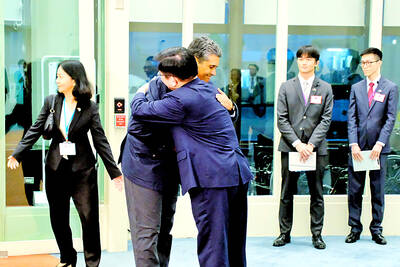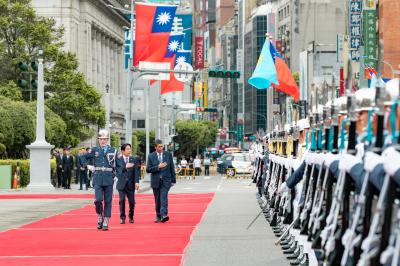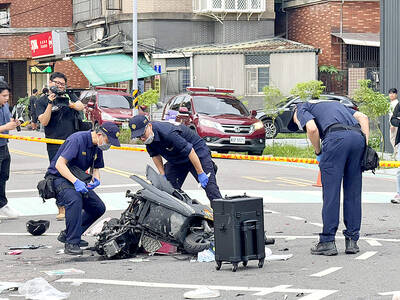Those who tremble at the sight of a needle may one day be able to receive immunizations via a DNA vaccine patch.
Funded by the National Science Council (NSC), the patches have been jointly developed by scientists from National Taiwan Ocean University, National Taiwan University of Science and Technology and Academic Sinica’s Genomics Research Center.
Research results on the patches were published in the May 4 issue of the Journal of Controlled Release.
National Taiwan Ocean University associate professor Wu Chang-jer (吳彰哲) said at a press conference yesterday that DNA vaccines are usually administered using an intramuscular injection or gene gun.
However, many patients are afraid of needles and syringes, and infections can result if the needles are not clean.
The cost of using gene guns to administer the vaccine is also high, he said.
Explaining how the DNA vaccine works, Wu said that the stratum corneum, the outermost layer of the epidermis, helps block the entry of substances coming from the outside.
The patch first removes the stratum corneum with hydroxy acids so that the DNA vaccine can enter the body through the skin.
The vaccine is also wrapped with liposomes, which stop the vaccine from being catalyzed and help join the vaccine and the cells so the antigen for a disease can be produced.
“The advantage of the DNA patch is that it is very stable and can be preserved under normal temperatures,” Wu said. “Since the patch does not penetrate the skin, there will not be any cross-infection issues.”
Wu said that only two patches are needed for the vaccines to take effect. Patients can take the patches off after two to three hours.
Wu said that the patches could be available in two years to 10 years, depending on how long it takes to complete testing and secure approval from the government.
The research team is trying to develop a DNA vaccine patch for Japanese encephalitis for mass production. It is planning to develop DNA vaccine patches for other epidemic diseases, such as SARS and avian flu.

Palauan President Surangel Whipps Jr arrived in Taiwan last night to kick off his first visit to the country since beginning his second term earlier this year. After arriving at Taoyuan International Airport at around 6:30 pm, Whipps and his delegation were welcomed by Minister of Foreign Affairs Lin Chia-lung (林佳龍). Speaking to gathered media, the Palauan leader said he was excited and honored to be back in Taiwan on his first state visit to Taiwan since he was sworn in this January. Among those traveling with Whipps is Minister of State Gustav N. Aitaro, Public Infrastructure

President William Lai (賴清德) yesterday thanked Palau for its continued support of Taiwan's international participation, as Taipei was once again excluded from the World Health Assembly (WHA) currently taking place in Switzerland. "Palau has never stopped voicing support for Taiwan" in the UN General Assembly, the WHO and other UN-affiliated agencies, Lai said during a bilateral meeting with visiting Palau President Surangel Whipps Jr. "We have been profoundly touched by these endorsements," Lai said, praising the Pacific island nation's firm support as "courageous." Lai's remarks came as Taiwan was excluded for the ninth consecutive year from the WHA, which is being held in

RESOLUTIONS DEBATE: Taiwan’s allies said that UN and WHA resolutions cited by China and other nations ‘do not determine Taiwan’s participation in WHO activities’ A proposal to invite Taiwan to this year’s World Health Assembly (WHA) was rejected on Monday, resulting in Taipei’s absence from the annual meeting for a ninth consecutive year, although partners spoke up for Taiwan’s participation at the first day of the meeting. The first agenda item after the opening was a “two-on-two debate” on a proposal to invite Taiwan to participate at the WHA as an observer. Similar to previous years, two countries made statements in favor of the proposal, while two others expressed their opposition. Philippine Secretary of Health Teodoro Herbosa, president of the 78th WHA, accepted the WHA General Committee’s

At least three people died and more than a dozen were injured yesterday afternoon when a vehicle struck a group of pedestrians in New Taipei City’s Sansia District (三峽). The incident happened at about 4pm when a car rammed into pedestrians at an intersection near Bei Da Elementary School. Witnesses said the sedan, being driven at a high speed, ran a red light, knocking scooters out of the way and hitting students crossing the road before careening into a median near the intersection of Guocheng and Guoguang streets. The incident resulted in three deaths and 13 injuries, including the driver, a 78-year-old man